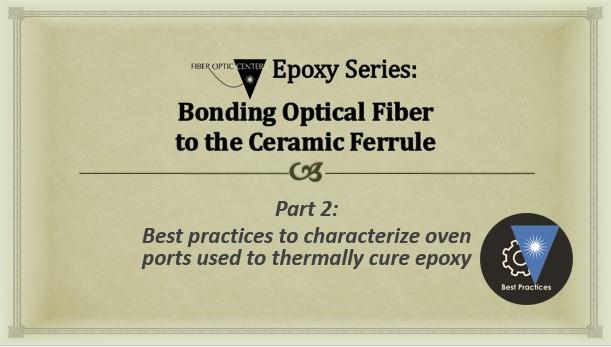Part 2: Bonding Optical Fiber to the Ceramic Ferrule
Introduction
When fiber optic cable assembly manufacturers ask us to help troubleshoot their epoxy curing issues, we find that some problems stem from improper mixing of epoxy. Other problems arise from lax cleaning procedures or improper dispensing of epoxy.
(See Part 1 of this article series to read best practices for epoxy preparation and dispensing.)
Curing temperatures also affect epoxy performance. Since temperatures in individual ports may vary, it’s good practice to periodically measure the temperature in ALL oven ports to ensure curing temperature consistency and stability.
This article explains one way to characterize your oven ports, along with helpful tips. When you follow these instructions, you may find that your curing schedule should be adjusted. Keep in mind, shipping a product that is not properly cured can be catastrophic to the cable assembly house. Without question, improving and validating your epoxy process can directly impact the long-term performance of your fiber optic cable assembly.

Why it’s important to characterize oven ports
If you use an oven to thermally cure epoxy, most likely the oven has multiple individual connector or ferrule ports. For example, your oven may have 24 individual ports, which can accept 24 connectors (one in each port). If your cable assembly house is receiving a new curing oven, it should be validated prior to acceptance to ensure it meets your requirements and functions appropriately – that is, it is capable of reaching the desired temperature set point and the temperature does not fluctuate too much during the curing time.
As a part of validating the oven, we recommend you also characterize all ports of a newly received oven – that is, you verify that ALL ports of the oven are performing similarly. Why is it important to characterize oven ports? You want to cure the epoxy-filled connectors using the most accurate curing schedule possible. The quality of the bond depends on this. And the quality of the bond directly impacts the long-term reliability of your product.
How to characterize oven ports
One way to characterize oven ports is by using a thermocouple probe inserted and potted with epoxy into a ferrule – just like when terminating a fiber, except you’ll be inserting the thermocouple tip instead of a fiber. Cure it, as you would a regular termination, and now you have a temperature probe that mimics your product exactly. For example, if you pot the thermocouple into an SC connector, now you have a thermocouple probe with an SC connector on one end, and your measurements will indicate the temperature INSIDE the connectors, which is really the temperature we are most concerned with.
Follow these steps:
- Use a 0.9-millimeter (900-micron) diameter thermocouple – or smaller, to ensure the thermocouple tip can fit inside the rear of a ferrule or connector you will use.
- Inject epoxy into the ferrule (or connector), and pot the thermocouple probe in the ferrule, so that the thermocouple tip is bottomed out against the base of the ferrule. (Do this as if you’re making a normal connector with optical fiber. Of course, there will be no fiber or anything within the ferrule bore, just the tip of the thermocouple positioned in the middle of the ferrule assembly.)
- Cure as normal. This will be your temperature probe: a ferrule (or connector) with thermocouple tip positioned in the center of the ferrule, right where the fiber strip point will be in your product. This is the area you want to ensure reaches your curing temperature set point.
- Place a thermocouple-connector probe into each port of your curing oven. Note how much time is needed for the center of the ferrule to reach the desired curing temperature, what the maximum temperature reached is, and how stable the temperature is throughout the curing time.
- Repeat the above steps to measure the temperature in every port. Since temperatures can vary port-to-port, this process will tell you whether the temperature is consistent across all ports in your curing oven.
- Characterize the oven ports annually, so you can track whether the temperature in all ports has remained stable over the past year. Adjust your curing schedule, or replace the curing oven as necessary.
Critical points to consider when characterizing oven ports – and adjusting your curing schedule
Let’s say your curing schedule is 100 degrees C for 10 minutes. That doesn’t mean you simply put a connector into a 100-degree oven for 10 minutes. The temperature experienced by the epoxy within the connector is influenced by the mass of the connector, so it may take 2 or 3 minutes for the epoxy’s internal temperature to reach 100 degrees C.
Your 10-minute timer should start when the epoxy’s internal temperature reaches the set point (in this case, 100 degrees C). When we say “characterize an oven port,” we want to see not only the actual temperatures reached in each port and how stable the temperatures remain throughout the cure cycle but also how long it takes for the internal temperature to reach the set point. You then establish your curing process based on that information. For example, if it takes 2 minutes for the connector to reach 100 degrees C, then you need to set your process time to 12 minutes – or 15 minutes as a buffer since you can’t really over-cure by time. If the epoxy curing time is a bit longer, there’s no problem. However, if the curing time is too short, there potentially can be problems with the bond. An incomplete cure will result in reduced bonding characteristics and, therefore, negatively affect long-term product reliability.
Additional tips regarding epoxy curing issues
- To validate your epoxy curing process, we recommend following the Telcordia GR-326 adhesive testing standard (section 4.4.4.2). Read more about this test in Part 3 of this article series.
- Avoid placing curing ovens where air may blow across the oven, for example, under a heating or air-conditioning vent. Oven heating surfaces should be covered and protected from drafts.
- Consider sending a representative sample of the real build through the production process, knowing you will destroy this sample later on to determine whether your product is built to full strength. Destructive testing is particularly helpful when establishing your bonding procedures. Cross-sectioning is a useful troubleshooting tool, because it offers a unique view inside connectors and can provide insight into why they fail. (Click HERE to learn about Fiber Optic Center’s cross-sectioning service.)
Conclusion
The consequences of deploying fiber optic cable assemblies that do not have properly prepared, dispensed, and cured epoxy can be catastrophic. That’s why your cable assembly house must have very tight controls in all aspects of the bonding process including the curing stage. Improving and validating your epoxy procedures can directly impact the reliability and long-term performance of your fiber optic cable assembly.
EDITOR’S NOTE: This is the second article in an ongoing series, “Bonding Optical Fiber to the Ceramic Ferrule.” Click to read:
- November 2017: Part 1: Best practices for epoxy preparation and dispensing
- December 2017: Part 2: Best practices to characterize oven ports used to thermally cure epoxy
- January 2018: Part 3: Best practices to validate your epoxy curing schedule
Click to learn more:
- Epoxy Bi-Pack News – and Usage Tips for Best Results
- Helpful Epoxy Tips (and a Few Tricks)
- Bond Line Thickness & More: Answers to Common Epoxy Questions
- Ideas to Adjust Your Epoxy Process: Recommendations to Reduce Waste (and Save Money) in Your Fiber Optic Cable Assembly Process
- Crystallization in Epoxies: Steps for You to Spot it – and Fix It.
- Crystallization in Epoxies: How to Identify and Reverse It
Additional resources from the FOC team include:
- View Epoxy Technical Solution Content
- View the Glossary, Acronyms, Military Specifications for Connectors
- Q&A Resource: email technical questions to AskFOC@focenter.com
- Bookmark the Adhesive/Epoxy Page and Contact Info




